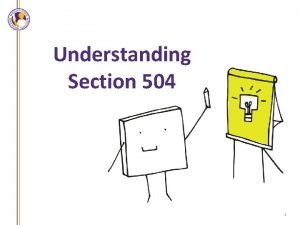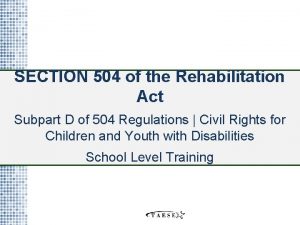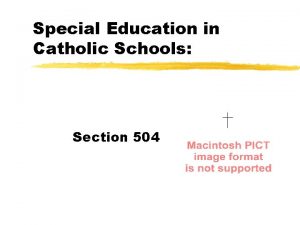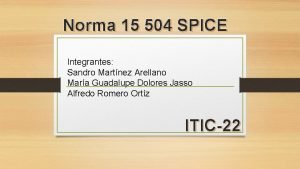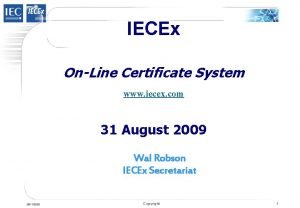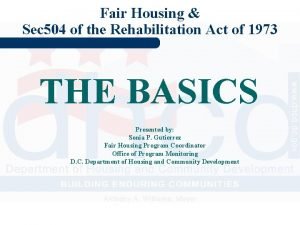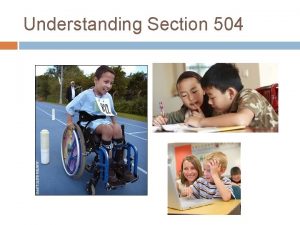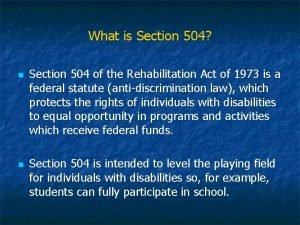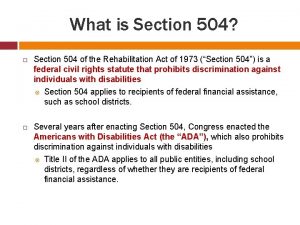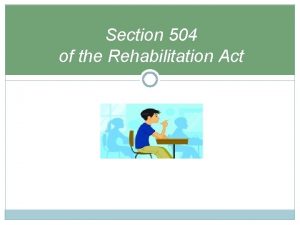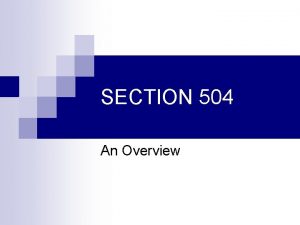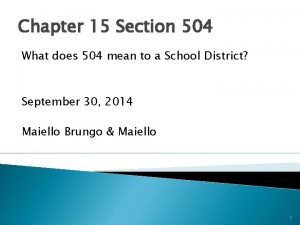Understanding Section 504 1 What is Section 504















- Slides: 15

Understanding Section 504 1

What is Section 504? 1973 Federal Civil Rights Law to stop discrimination against people with disabilities in programs and activities that receive federal funds*, including public schools. Ensures that a child with a disability has equal access to educational opportunities provided to their non-disabled peers. *Note that federal funding is not provided to support 504 modifications. 2

Why is Section 504 Important? Section 504 provides services and changes to the learning environment to remove barriers and enable students to learn alongside their peers. The school must meet a child's educational needs and right to a Free and Appropriate Public Education (FAPE) 3

What is the Difference between a Section 504 Plan and an IEP? Type of Law Eligibility Requirements Includes Section 504 Plan IEP (Individualized Education Program) Civil Rights Education Disability significantly impairs a major life function (may not have an educational impact) Disability must: • Meet criteria under IDEA • Significantly impact educational performance • Require specialized services Mostly accommodations, sometimes modifications and related services Accommodations, modifications, courses, related services Age No age limits 3 to 21 years Length Paperwork can be used as a guide for college Ends with high school graduation Committee in School Optional based on school policy Mandatory Dispute Rights Less recourse Parents/guardians have due process and procedural safeguards Parent Involvement Recommended Required Federal Funding None Yes 4

Who Qualifies for Section 504? Any child th at has disab ilities that interfe re with the c hild's ability to lea rn in a gene ral education c lassroom (5 04 has a broad er definition of disability th an IDEA, so a child who d oesn't quali fy for an IEP migh t still get a 5 04 plan) clude Disabilities can in ental any physical or m impairment that s a substantially limit (similar y it v ti c a fe li r jo a m for to ADA guidelines individuals in the workplace) to e v a h t es no o d d l i for y f i l A ch a u ng to q isability i l i a f e b heir d T act . t p r o m i p p n su ave a h o t s just ha ducation. ir e on the 5

How does Section 504 work? 504 plans do not have to be written and there is not a standard template. Generally, plans include: • specific accommodations, supports, or services for the child • name of who will provide each service • name of the person responsible for ensuring the plan is implemented The plan can also • modify or change what a child is expected to learn • include specialized instruction • include specialized services like speech or occupational therapy 6

How does Section 504 work? Parents/Guardians must be notified about significant educational changes like identification, evaluation, and classroom placement The school's decision can be challenged via the school and/or district personnel, state department of education or protection and advocacy agency, Office of Civil Rights, or, as a last resort, a lawsuit School districts are required to establish grievance procedures for resolving complaints in a prompt and equitable manner 7

Possible Accommodations ts s e t n o e • extra tim tions op g n i t a e s • ies g e t a r t s l a • addition • tutor y g o l o n h c e t • assistive t • oral tes tion a administr • sign l anguag e interp • beha reter vior con tracts • organ izationa l/time manage • extra ment strategi es duty co ntracts approp (to hav riate st e aff at e curricul xtra ar/athle tic even ts) 8

Considerations • There are often challenges at the family level as a result of a service member diagnosed with PTSD, including children experiencing behavioral problems. • A specific diagnosis like anxiety or depression is unnecessary. The 504 planning team can determine there is a need for accommodations and create a plan to help the student if the problems are affecting the student’s ability to learn. 9

Transition Considerations • The Military Interstate Children’s Compact provides that for up to one year after a parent is medically discharged, retires, or dies on active duty, the receiving district must honor an existing Section 504 plan. • The Compact requires receiving schools to comply with an existing Section 504 plan and to make reasonable accommodations and modifications for incoming students with disabilities • The receiving school may perform subsequent evaluations to ensure appropriate placement and services • Parents are encouraged to provide all previous Section 504 and supporting documentation to the receiving school 10

Next Steps • Document your child's needs. This could include health records showing a medical diagnosis, schoolwork, report cards, private evaluations, etc. Military-connected parents are encouraged to hand-carry this documentation when transferring. • Every public school district must have a 504 coordinator (may also be the IEP coordinator). Check the school/district website and/or ask the campus principal. 11

Next Steps • Collaborate with the school/district team to complete the process. If you are not sure whether your child needs an IEP or a 504 plan, request an evaluation for an IEP. • 504 plans should be re-evaluated every 3 years at a minimum, but are only required to be reviewed periodically. Best practice is to review the plan annually (ensure the plan is implemented and working) and re-evaluate as needed (change accommodations). 12

Moving Forward The plan can be terminated if the 504 team determines the student is: • no longer disabled • no longer requires any special accommodations or services to meet the identified needs • can be appropriately instructed in general education 13

For More Information Parent and Educator Resource Guide to Section 504 in Public Elementary and Secondary Schools (Published by US Dept of Education Office for Civil Rights, Dec 2016) Understood. org IEP vs 504 Your Rights in the 504 Process Steps to Getting a 504 Plan for Your Child Section 504 Resources at the Center for Parent Information & Resources Military Interstate Compact and Section 504 (page 11) Section 504 Resources on Wrightslaw (Special Education Law and Advocacy) For the Sake of the Child Podcast: 5 Actions for Exceptional Parents with Dr. Paul Ban (as posted on Podbean; part of a longer MCEC webinar) 14

Created by the Military Child Education Coalition® in partnership with the Wounded Warrior Project® We encourage you to share the material in any medium or format with appropriate acknowledgement of the Military Child Education Coalition®. You may adapt the material as long as the intent remains unchanged and the modifications are explicitly noted. 15
 Section 502 guaranteed rural housing loan program
Section 502 guaranteed rural housing loan program Section 504 home repair program
Section 504 home repair program Section 504
Section 504 Bridge loan
Bridge loan Section 504
Section 504 Trgs 504
Trgs 504 Idea vs 504
Idea vs 504 Factorizacion prima de 360
Factorizacion prima de 360 Universal design for learning definition
Universal design for learning definition Celiac 504 plan
Celiac 504 plan 504 plan catholic schools
504 plan catholic schools Blink htlm
Blink htlm Manifestation meeting for 504
Manifestation meeting for 504 Norma spice
Norma spice Iecex.com
Iecex.com Sec 504
Sec 504


